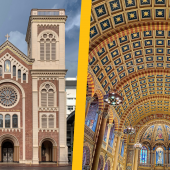Seraphic Connotation of the Holy Rosary
On October 7, 1571, Europe defeated the Turks at the Battle of Lepanto, saving Christian civilization. Pope Pius V established the Feast of Our Lady of Victory on this date to thank Mary for her role in the victory. Since the triumph was a result of the Holy Rosary, it became the Feast of Our Lady of the Rosary.
Genesis of the Rosary
The origin of the Rosary itself is said to stem from a mysterious legend according to which Saint Dominic, founder of the Order of Preachers, was, in 1206, facing failure at converting the Albigensians in Prouille, France, back to the Catholic faith, until, in a beatific vision, he was given the Rosary by Our Lady as a tool against heretics. The Rosary devotion, however, was popularized by a Dominican preacher, Alan de la Roche (d 1475), and his confreres in the 15th century, in northern France and Flanders, whence it spread to the rest of Europe.
Pope Leo X accorded it official approbation in 1520 and declared October the month of the Holy Rosary. The feast was permanently placed on the liturgical calendar of the Universal Church in 1716 when Prince Eugene won another important victory over the same enemy in Hungary.
The term “rosary” comes from the Latin rosarium, which variously implies a rose garden, a bed of roses, a garland of flowers, or a collection of nice quotes. The roots of the Christian Rosary lie in an ancient daily prayer devotion of reciting 150 times the Our Father, later simplified to 150 Hail Marys. The largely illiterate Christians of the Middle Ages used strings of beads to keep count. The Rosary as we use it today is a simplified version of the Dominican rosary, which consisted of 15 decades of the Hail Mary to the accompaniment of meditation on 15 mysteries pertaining to the life, suffering, death, and glorification of Jesus and Mary based on scripture. These mysteries fall into three divisions, called “chaplets” of 5 mysteries each, viz the Joyful, the Sorrowful, and the Glorious Mysteries.
Modern development
Pope Saint John Paul II, through his Encyclical, Rosarium Virginis Mariae of October 16, 2002, added a set of five new mysteries to the rosary, viz, the “Luminous Mysteries”: The Baptism of Jesus in the River Jordan (Mt 3:1-17); Jesus’ Self-manifestation at the Wedding at Cana (Jn 2:1-12); Jesus’ Proclamation of the Kingdom with a Call to Conversion (Mk 1:14-15); his Transfiguration (Lk 9:28-35); and the Institution of the Eucharist (Jn 13:1-15) as the sacramental expression of the Paschal Mystery.
With the four sets of mysteries in place, the rosary now spanning 20 decades, can be said to have metamorphosed from being a simple Marian Psalter comprising 153 Hail Marys to a virtual summary of the Church’s liturgical year, Christian truth represented with comprehensive brevity. The recitation, commencing as it does with the Apostles’ Creed, followed by Our Father, three Hail Marys, and the Doxology, has emerged as a perfect form of prayerful tribute to the Blessed Trinity.
Each decade of the Hail Mary is then preceded by Our Father and concludes with the Doxology, thus highlighting the significance of the Lord’s Prayer as the key prayer of the rosary. Mary’s own ejaculatory Fatima prayer (1917), “O my Jesus, forgive us our sins! Save us from the fires of Hell! Lead all souls to Heaven, especially those who most need your mercy,” recited after the doxology completes each decade. The recitation of the “Hail Holy Queen” at the end of each set of 5 decades acknowledges Mary’s ongoing role in our salvation as only next to that of Jesus.
A Herald & Knight….!
Not quite widely known is a Franciscan Rosary titled the “Franciscan Crown” with a history of its own, stemming as it does from the tradition of devotion to and love for the Blessed Mother of God received by the Franciscan Order from Francis d’Assisi. Texts relating to Francis keep emerging, confirming that the Poverello of Assisi was not only the indefatigable “Herald of the Great King” but also the faithful “Knight of the Great Queen.”
On February 24, 1208, in the centuries-old chapel of Saint Mary of the Angels in Assisi, also known as the Portiuncula (“little portion”), Saint Francis perceived clearly at Mass the Lord’s plan for him in Matthew 10:5-14. Here was for the most part his permanent abode, after the Benedictines of Cluny presented him (c 1211) with the Portiuncula where he also died on Saturday, October 3, 1226. Though a layman, he preached passionately to all and sundry, the very simplicity of his life and teaching drawing around him men of prominence, like Bernard da Quintavalla, wealthy merchants like Giles the ecstatic, and others. On April 16, 1209, with the enrobing of Peter of Cattaneo, a Canon of the Cathedral, was born the Order of Friars Minor—Fratres Minores, “little brothers”, with a rule-based purely on the Gospel, viz., “to follow the teachings of Our Lord Jesus Christ and to walk in his footsteps”, and with Mary, Queen of the Angels, as their guide and protector.
Marian devotion par excellence
Francis endeavored to follow Christ so closely as to surrender his life into the hands of the Heavenly Father. He therefore could not help but love in a special way the pure and most holy Virgin, who was chosen by the Father to be the mother of His divine Son. From his own writings, it can be deduced that Francis clearly perceived and presented Mary as the model of every Christian who responds to the presence of God in their lives.
From the writings of the earliest biographers, such as Thomas of Celano, who wrote his first biography at the insistence of Pope Gregory IX for the canonization of Francis in 1228/29 and his “second life” in 1247, Francis’ love for Mary comes through as so much a part of him that it is almost impossible to separate his Marian devotion from his daily life.
Francis was a man of his time, and, though not a theologian in the strict sense of the term, he absorbed with his childlike faith the Church’s teaching on the Mother of God and nourished his Marian spirituality on it. Prayer and meditation introduced him ever more deeply to the heart of the Marian mysteries and gave him a greater understanding of her preeminent role in God’s plan of salvation; his utterances, both verbal and written, show us the fruit of his prayer in a way so personal, so original, and so unique as to still move us today, eight centuries later. As Bernardine de Bustis (d c 1515) attests: The seraphic father himself admonished his brethren that they should attribute to the blessed Mother of God every privilege which may be appropriate to her excellence and that they should exalt her with all the praise that is appropriate for such a pure human creature.
According to Saint Bonaventure (d 1274), another of Francis’ early biographers, Francis placed himself and his order under the protection and guidance of Mary for all time - On one side we should show Mary in all her poverty of Bethlehem placing the sweetest son of God upon the rough straw of the manger. In the other half of our painting, we would portray Mary, the Immaculate Mother of God, and Queen of the Seraphic Order, in the chapel of Mary of the Angels stretching forth her arms in motherly protection over all her Franciscan sons and daughters.
From his earliest days, according to Celano, Francis “burned with devotion toward the mother of all good.” When Francis abandoned the world, he placed himself under the loving care and protection of his heavenly Mother. He asked her to be his guide and advocate in his new life of poverty after the pattern of her Son. Celano avers: He embraced the Mother of Jesus with inexpressible love since she made the Lord of His Majesty a brother to us. Bonaventure adds, “And, through her, we have obtained mercy.” He honored her with his own Praises, poured out prayers to her, and offered her his love in a way that no human tongue can express. But what gives us the greatest joy is that he appointed her the Advocate of the Order and placed under her wings the sons he left behind, that she might protect and cherish them to the end.
For Francis, the Incarnation was the basis of his whole spiritual life, and he would go out of his way to follow in every way possible the example of the Word-made Faith. Therefore, it would seem only natural that he “owed” a special love to this unique woman, who brought God within our reach and “made the Lord of Majesty a brother to us.” That is where the Franciscan Crown comes in!
Franciscan Crown
This Rosary comprises seven decades in commemoration of the Seven Joy-filled Episodes in the Life of the Blessed Virgin Mary, viz, Annunciation (Lk 1:26-38); Visitation (Lk 1:39–56); Jesus’ Nativity (Lk 2:6-7); Adoration of the Magi (Mt 2:11); Finding in the Temple (Lk 2:41–52); Jesus’ Resurrection (Mt 28:1–11); and finally, either or both the Assumption of Mary and her Coronation.
Especially popular with the Franciscans, the Cistercians, and the Annunciades of Saint Jean d’Arc of France, the devotion, also called the Seraphic Rosary, was granted many indulgences by different popes, eventually becoming the most heavily indulgenced devotion in the Catholic Church.
The practice originated among the Franciscans in early 15th-century Italy, with themes resembling the 12th-century Gaudes and Latin praises that ask Mary to rejoice because God has favored her in various ways. The Franciscan historian Luke Wadding (1588–1657) dates the origin of the Franciscan Crown to the year 1422, in which year the Blessed Virgin Mary is said to have appeared to a Franciscan novice named James.
As a child, James was accustomed to offering the Virgin a crown of roses daily. On entering the Friars Minor, he was distraught at the thought of no longer being able to offer this gift. In an apparition, Mary comforted him by suggesting another daily offering that he might do: to pray every day for seven decades of Hail Marys, meditating during each decade on one of the seven joys that marked her life.
According to Charles Sammons, "The Franciscan Crown offers us a chance to meditate on certain mysteries that we do not find in the traditional Dominican Rosary, such as the Adoration of the Magi." Meditating on each mystery, an Our Father and ten Hail Marys are prayed in order. Customarily, after the seventh decade, two additional Hail Marys bring the total number to seventy-two in honor of the tradition that Mary lived for seventy-two years.
In conclusion
The rosary, according to Pope Pius XII, has special intercessory efficacy and thus possesses great power to enlighten and sanctify those who pray it. Therefore, whether one prays the Dominican Rosary or the Franciscan Crown, we have Saint Louis de Montfort affirming, “Never will anyone who prays his Rosary every day be led astray. This is a statement that I would gladly sign with my blood!”
Radio Veritas Asia (RVA), a media platform of the Catholic Church, aims to share Christ. RVA started in 1969 as a continental Catholic radio station to serve Asian countries in their respective local language, thus earning the tag “the Voice of Asian Christianity.” Responding to the emerging context, RVA embraced media platforms to connect with the global Asian audience via its 21 language websites and various social media platforms.















